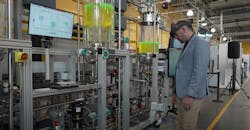Enabling the Industrial Workforce for a Mobile Future
Because the digital transformation of industry is so clearly focused on data and technology, it can be easy to lose sight of the human aspect of this change. But enabling humans—from frontline plant floor operators to corporate executives—to do their jobs better and make their businesses more efficient and profitable is, ultimately, why the digital transformation is taking place.
That’s why Dow Inc. partnered with Siemens and MxD (the Chicago-based center built in partnership with Department of Defense to advance U.S. manufacturing) to create a testbed for the optimization of tools for a more mobile industrial workforce. The testbed centers around a separation column—commonly used in the processing industries for multi-stage processes such as distillation, stripping, absorption, and extraction—outfitted with an array of Siemens technologies.
At the 2022 ARC Forum, representatives from Siemens, Dow, and MxD showcased this new testbed, which is open to all manufacturers looking to learn more about it and contribute to its ongoing development. (You can learn more about working with this system at www.mxdusa.org).
“The changes we’ve seen in the workforce recently are important to recognize when you’re focused on creating a system that enables a new worker to learn a system with the aid of technologies like augmented reality (AR),” said Ortiz. “Companies don’t have time for new workers to come onboard and make mistakes, so the tools have to be there and accessible from anywhere to provide access to [components like] SCADA, HMIs, and controllers. Plus, younger engineers like having this access to data and don’t understand why manufacturing technologies don’t just work together.”
Dow’s focus on the mobile workforce
Explaining Dow’s work with Siemens and MxD on this project, Katelyn Kelsey, mobile technology engineer at Dow Digital Operations Center, said, “Digitalization is not new to Dow. We are aggregating cross-discipline teams to create digital centers that can be used to discover new technologies for a more sustainable plant architecture and understand what frontline worker support will look like in the future. We want to develop technologies for mobile fieldworkers so they can have access to all the information they need at all times to do their jobs.”
She added that this shift in focus toward the human component of operations is important because “the way we are learning is fundamentally changing. We’re moving from reading manuals to watching YouTube videos and pulling up information on AR glasses. We have to have tools that match the way we learn and do work.”
Laura Coates, vice president of process automation at Siemens Industry, said, “This is a great example of partnering with one of our customers, Dow, and with MxD to bring real-world use cases provided by Dow into a place where customers can come in and see exactly how digitalization can work for them. We can provide a huge spectrum portfolio of technologies—from the instrumentation in the field to the networking that will connect it to the cloud, to the control system that can run their whole process operation.”
Siemens technology in the testbed
The Siemens SIMATIC PCS neo controlling the separation column in the testbed is “the world's first completely web-based process control system,” said Ortiz. “That means you can use any device that supports a web browser to access either the engineering or the operations environment of the control system. And it has a lot of built-in functionalities to help an operator do their tasks. For example, the alarm system will help the operator understand what events are taking place in the plant so they can address the highest priority events first.”
Ortiz added that he’s been involved in many commissioning projects where the plant manager wants to know what devices in a system are currently interlocked or in bypass mode. “With SIMATIC PCS neo, I can find all those with just two clicks—it connects to anything using open standards that are available in industry today.”
In addition to the PCS neo hardware and software and SIMIT simulation software used in the separation column testbed at MxD, other Siemens technology used include:
- Simcenter FloMaster for advanced engineering simulation;
- Teamcenter and NX for digital lifecycle management;
- COMOS to integrate engineering and operations of the process control system;
- Walkinside for 3D virtual reality visualization;
- SIDRIVE IQ for cloud monitoring of rotating electrical equipment;
- SITRANS store IQ for cloud monitoring of sensors and tanks;
- PCS myExpert for process control system health and lifecycle monitoring in the cloud;
- MindSphere for edge-to-cloud data analytics;
- SIPIX for mobile asset management using rugged Windows-based tablets;
- PA DCP for cybersecurity of process automation networks;
- PA Consulting for technology evaluation at brownfield sites;
- Digital Enterprise for creating comprehensive digital twins;
- Process instruments to measure flow, level, pressure, temperature, and valve position; and
- Drives to control the system’s actions.
Kelsey noted that, while IT’s involvement in this project has been critical to understanding the long-term support needs of a system like this, “we also have users at the table to help us understand what’s realistic about what we’re creating. For example, how many clicks does it take for users to get to the information they need? We also realize the need for this system to be adaptable, as the technology we’re using today will likely change in the next two years,” she said.
Dow’s ultimate vision for this testbed is for it to serve as a guidepost for the development of mobile worker technology so that operators will soon be able to walk into a facility and have access to the tools they need just by picking up a tablet and accessing the information via pervasive wireless in the plant, without needing to know about IT and networking, said Kelsey.
About the Author
David Greenfield, editor in chief
Editor in Chief

Leaders relevant to this article:



